Leap Frogs
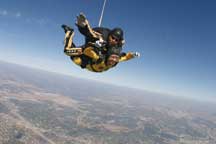  Football coach Gary Patterson, in yellow at left, and Mary Volcansek, dean of the AddRan College of Humanities and Social Sciences, in yellow at right, were on top of the world this fall. Football coach Gary Patterson, in yellow at left, and Mary Volcansek, dean of the AddRan College of Humanities and Social Sciences, in yellow at right, were on top of the world this fall.
The Golden Knights, the U.S. Army parachute team, invited the duo along for a tandem jump the day before TCU’s homecoming game against Army. At the Oct. 15 game, the award-winning Golden Knights, based in Fort Bragg, N.C., parachuted onto the field at Amon Carter Stadium toting the game ball and carrying the U.S., TCU and POW/MIA flags. Photos courtesy of the Golden Knights.

Building a $110.2 million vision
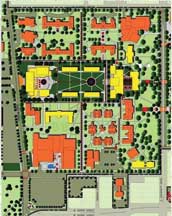 A new student union. New dorms. A park-like swath of grass connecting it all to Frog Fountain. And an expanded home for the School of Education. This was the vision presented in November when the Board of Trustees approved Phase I of the campus master plan, which evolved from the campus strategic plan known as Vision in Action. A new student union. New dorms. A park-like swath of grass connecting it all to Frog Fountain. And an expanded home for the School of Education. This was the vision presented in November when the Board of Trustees approved Phase I of the campus master plan, which evolved from the campus strategic plan known as Vision in Action.
The $100 million campus commons project is aimed at turning the center of campus into the heart of the University,. The project, which is scheduled to get underway next summer, will add four new residence halls and a university union, and turn what is now a field of asphalt into an expansive green space. Bonds funds will account for $80 million, with the remaining $20 million scheduled to be raised.
 Additionally, a $10.2 million donor-funded construction project will nearly triple the size of the School of Education facilities from 14,000 square feet to 40,000 square feet and restore the original splendor that the Bailey Building had when it opened in 1914. The School of Education project is scheduled to be completed by 2007, and the campus center by 2008. Additionally, a $10.2 million donor-funded construction project will nearly triple the size of the School of Education facilities from 14,000 square feet to 40,000 square feet and restore the original splendor that the Bailey Building had when it opened in 1914. The School of Education project is scheduled to be completed by 2007, and the campus center by 2008.
“What’s key is we’re taking the center of campus and making it truly the crossroads of the campus,” said Don Mills, vice chancellor for student affairs.
Chancellor Victor Boschini Jr. said the project would more closely tie the academic life of students to their experience outside the classroom. Mills said he envisions 24-hour food service and 24-hour computer access as featured amenities of the campus commons.
“One of the things we want to do is bring the academic programs and the residential programs together,” Mills said.
The new on-campus housing is expected to increase the number of students living on campus to more than 4,400 – 1,000 more than are currently housed on campus.
Boschini said living on campus enhances students’ academic performance and their overall experience. Parents of TCU students tend to agree, he said.
“Most parents I talk to, the first thing they want is for their children to live on campus,” Boschini said.
The on-campus living experience will be enhanced by the addition of the new university union, which will offer food services, indoor and outdoor dining, a conference center, offices for student organizations and space to host lecturers and plays and other activities. The conference center will be used for TCU events but will also be available for use by organizations in the Fort Worth community, Boschini said.
To create room for the new campus center, 300 parking spaces will be eliminated. But Boschini said 1,000 new spaces will be made available on the outer portions of campus and increased shuttle service will provide service from parking lots to locations in the center campus.
The second phase of the project, which has not yet received funding, will convert the Brown-Lupton Student Center into academic and programming space. Jarvis and Milton-Daniel residence halls will also be remodeled in the next phase. The refurbished Jarvis will be converted to academic space.
On the south end of campus, the refurbished Bailey Building should make that entry point into campus more distinct, Boschini said. The facility will be restored to its classical look with columns and a stairway leading up to the entrance.
The building will connect with a new wing that will provide not only more but better classroom space for education classes. Some education classes are currently taught in temporary buildings west of the Bailey Building.
“We’re going to make the quality of the facility match the quality of the education,” Boschini said.
Vision in action
The construction of a campus commons and enhancements planned for the School of Education facility accomplishes major goals set by TCU’s Vision in Action strategic planning initiative launched by Chancellor Victor J. Boschini Jr. in 2003.
“Our goals are, and should be, lofty,” Boschini said. “We don’t want to limit our aspirations.”
The projects are in line with VIA’s four strategic decisions:
• To cap undergraduate enrollment at 7,200 through 2009-2010;
• To house two-thirds of undergraduates in university-owned or university-auth- orized housing over the next decade;
• To grow selected graduate programs over the next decade;
• To dedicate a percentage of tuition revenue for investment through the Strategic Initiative Fund Program
The investment in facilities and infrastructure will also be a step toward fulfilling the five cardinal goals outlined by VIA:
• To recruit and retain students, faculty and staff who can achieve their full potential at TCU;
• To design a vibrant learning community characterized by distinctive curricular, co-curricular and residential programs;
•To sustain an environment in which rich personal interaction is enhanced by outstanding facilities and appropriate technology;
• To accelerate the University’s connection with the larger community — Fort Worth, the nation and the world;
• To couple wise financial stewardship with a well-planned entrepreneurial approach to academic opportunities

Remembering their service
TCU’s long history of military servi ce has not been forgotten. A new campus showpiece, the Veterans Plaza, honors the sacrifices and accomplishments of alumni and students who served in World War I and II, Korea, Vietnam, the first Gulf war and the current military operations in Afghanistan and Iraq. The plaza was dedicated in a Nov. 12 ceremony attended by Texas Secretary of State Roger Williams ‘72. ce has not been forgotten. A new campus showpiece, the Veterans Plaza, honors the sacrifices and accomplishments of alumni and students who served in World War I and II, Korea, Vietnam, the first Gulf war and the current military operations in Afghanistan and Iraq. The plaza was dedicated in a Nov. 12 ceremony attended by Texas Secretary of State Roger Williams ‘72.
“Here at TCU, we have a hall of fame for our renowned athletes, a hall of fame for outstanding musicians. We have educational accolades for our greatest scholars, and many more,” Williams said. “But until today, we have lacked a fitting memorial for what I feel are TCU’s most important graduates.”
The plaza encompasses existing memorial pillars that were constructed as part of a memorial arch in 1923 to honor World War I veterans, and then in 1949 were re-dedicated to honor vets of both World Wars. The new plaza includes garden areas and walkways that span from the east side of Reed Hall to a fountain northwest of the Mary Couts Burnett Library.
On the west side of the monument a grove of trees symbolizes the unity of the soldiers, while a gap in the grove, which will let sunlight through during the day, honors those soldiers who died in war. In the grove are plaques listing the names of the fallen.

Texas Flags waving goodbye
It’s your last chance to the see The Historical Flags of Texas exhibit, sponsored by the Center for Texas Studies, and curated by Robert Mayberry Jr. ‘87 (MA), (PhD ‘92), adjunct history faculty. The traveling exhibit, which opened two years ago in Austin, is on display at the National Cowgirl Museum and Hall of Fame in Fort Worth through Feb. 12, 2006.
For information, call 817.336.4475 or go to www.cowgirl.net.

Over there
Showing their colors. 1st Lt. Aaron Price '03 writes that he has been hanging out with his buddy from TCU ROTC again thanks those who sent TCU flags. “One got hung up in the DFAC proudly, and the other one got taken around to many different spots so we could find the best picture.” Here Price and 1st Lt. Valerie Wallis '02 show their pride at Camp Victory in front of the Corps Headquarters.

Frogs of a different color
Normally purple-clad fans were pink for a day. The TCU community donned pink on Nov. 5 to lend a helping hand to the Susan G. Kome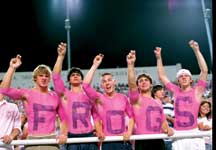 n Foundation. At the “pink out” event, which coincided with the football team’s game against Colorado State at Amon Carter Stadium, a portion of the proceeds from ticket, T-shirt and merchandise sales were donated to the Tarrant County affiliate of the Komen Foundation. n Foundation. At the “pink out” event, which coincided with the football team’s game against Colorado State at Amon Carter Stadium, a portion of the proceeds from ticket, T-shirt and merchandise sales were donated to the Tarrant County affiliate of the Komen Foundation.
The event was expected to bring in more than $10,000 for the Komen Foundation. The foundation helps offset medical care costs for under-served and underinsured breast cancer patients, provides free mammograms and pays for educational services.
Reducing risk
Suzy Lockwood ‘83, assistant professor in the Harris School of Nursing, offers these tips for reducing your risk for breast cancer:
1) Quit smoking.
2) Eat at least 5 fruits and vegetables a day.
3) Eat fruits and vegetable with carotenoids (oranges, carrots, etc).
4) Eat green leafy vegetables.
5) Limit alcohol intake.
6) Exercise at least 30 minutes every day.
7) Reduce excess body fat.
8) Limit calorie intake to recommendations for your age and weight.
9) Know your family cancer history.
10) Have your annual physical examination and do breast self-examinations.

Music around the world
The TCU Symphony Orchestra performed in the Festival Iberoamericano de las Artes in Puerto Rico in October. The renowned event features opera, choir, jazz, theater and dance performers from around the world.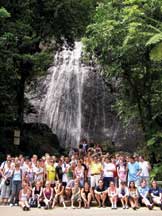
Seventy-two students made the weeklong trip, which included performances in the cities of San Juan and Ponce. The festival director was so impressed by the orchestra’s performance that he invited them back to next year’s event.
“The budget won’t allow us to go back again, but it is a big honor,” said Liz Branch, special events coordinator for the orchestra and the Center for Latin American Music. “It’s easy to get invited to an event but harder to get invited back. If you get invited back, it’s because they have heard you perform and liked it.”
During the trip, the students soaked in the sites and sounds of the El Yunque rain forest and also spent time at two beaches, Luquillo and Isla Verde.

New stone age comes to campus
Stonehenge has piqued the curiosity and wonder of scientists and tourists for centuries. Like the famous stone circle in southern England, a newly constructed “Froghenge” has no doubt drawn the attention and curiosity of passersby on the TCU campus.
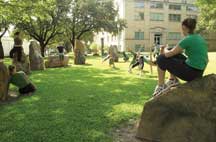
Situated in the shade of sprawling oak trees just north of the Bailey Building, The Megalith at TCU, as it is formally known, is a testament to the ancient man-made circles found in the British Isles and elsewhere. But unlike the slowly crafted towering mementos of prehistory, this display was constructed in the span of a week.
The TCU Megalith, which Provost Nowell Donovan modeled on megaliths in Scotland, comprises 11 stones: a recumbent (flat lying) block of quartzite from Idaho, two tall flankers and eight other blocks of Oklahoma sandstone. The stone circle is 15 megalithic yards in diameter (40.5 feet), and includes three outlying monoliths placed at a 120-degree angle to each other. The monoliths — which point to the Robert Carr Chapel, The Bailey Building and the Ballet Building — and the recumbent stone represent the University.
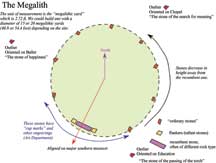
The recumbent stone is the Stone of the Teacher and signifies debate and a focus on instruction. The Stone of the Search for Meaning, aimed at the chapel, represents the driving force that connects the past to the future. The Stone of Happiness, pointing to the Ballet Building, represents the happiness that comes from knowledge rather than ignorance. The Stone of the Passing of the Torch, aimed at the Bailey Building, represents the primary academic responsibility of the University.
The Megalith is already being used by professors and student groups at TCU as the site of theatrical performances, concerts and picnics. Donovan said the stone circle is also a quiet place where people can be alone with their thoughts.
“I sometimes think that in our zeal to fill each other’s lives with lively action, we forget our need for private time of quality,” he said.

Hero worship
Usually a droll, monotone delivery would make for a boring lecturer. But when it’s Ben Stein, the famous presidential speechwriter and film and TV actor, deadpan is his calling card.
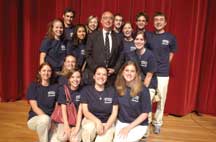
Stein, probably best known to today’s college students as the host of Comedy Central’s quiz show “Win Ben Stein’s Money”, was the featured speaker at the Fogelson Honors Forum Oct. 5.
Stein entertained the audience with amusing anecdotes, but he also spoke seriously about who our real role models should be and why Americans should consider themselves blessed for all they have instead of bickering over politics.
“I think the real heroes are the ones wearing full body armor in 130-degree heat,” Stein said of U.S. soldiers serving in Iraq.

Same but different
The TCU/Cliburn Piano Institute has a new moniker: PianoTexas, International Academy & Festival.
The institute’s status as a world-renowned event, however, remains intact. Each June, the institute attracts a collection of the world’s most talented young performers, as well as experienced piano teachers and top-notch amateurs, to the TCU campus.
The month-long festival includes master classes, private lessons, recitals, lectures, seminars and other unique opportunities for participants, including a chance to perform with the Fort Worth Symphony Orchestra or a chamber group. Recitals are open to the public.
PianoTexas will be June 2-25, on the TCU campus. For more information, www.pianotexas.org.

A center's attention
The Washington Center for Internships and Academic Seminars recently honored TCU as a distinguished affiliate. TCU is one of only 30 institutions to receive the honor from the center, which has worked with more than a thousand colleges and universities in the United States and abroad.
Judith Gill, chancellor of the Board of Higher Education in Massachusetts, cited TCU as “one of the schools doing the very best job of making available to their students the opportunities the Center offers.” It has “far-sighted leaders at the top who support the program and an able, dedicated campus liaison who makes it work for students,” she said.
For the past 28 years, TCU has sent approximately 15 students each fall to Washington, D.C. There they have served as interns in the White House, in virtually every executive branch department and agency, in Congress, and in assorted other governmental entities like the U.S. Attorney’s Office, the Library of Congress and Voice of America. Interns have also been placed in a variety of non-governmental organizations dedicated to public service.
The Washington Center is a non-partisan, nonprofit organization that extends colleges’ and universities’ offerings by providing selected students of all majors an internship-centered academic semester or summer term in the nation’s Capital.

Greek ideals
Students in Greek organizations were challenged to remain committed to the ideals which fraternities and sororities are supposed to stand for during the 2005 Martin Delta Gamma Lectureship in October. The panel of national leaders who gathered to discuss the future of Greek life for the annual ethics lecture included Martha Brown, chairwoman of the National Panhellenic Conference; Jennifer M. Jones, national vice president of the National Pan-Hellenic Council; Monica Miranda-Smalls, director of fraternity and sorority life at the University of Rochester; and Thomas G. Goodale, executive director of Sigma Alpha Epsilon.

Circle of Excellence 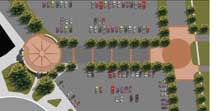
Donors are more than halfway to funding a $200,000 Greek plaza featuring a Circle of Excellence. The plaza will stretch from the proposed University Union across Stadium Drive to the entrance of Amon Carter Stadium.
The centerpiece will be next to Daniel-Meyer Coliseum — a Circle of Excellence featuring a wall of honor of Horned Frogs who have achieved distinction in the classroom and on the playing fields. At the center of the circle there will be a sculpture of a horned frog. Contributions are still being collected. of Excellence featuring a wall of honor of Horned Frogs who have achieved distinction in the classroom and on the playing fields. At the center of the circle there will be a sculpture of a horned frog. Contributions are still being collected.
For information, call 817.257.5032 or e-mail d.tinney@tcu.edu.

Gates to understanding
Bruce Feiler believes people of different religions can use their faith to find common ground. But the popular author and public speaker cautions that before people can bridge the gap between their faiths, they must first understand the differences that divide them.
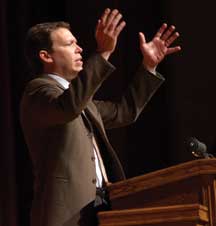
Feiler was the featured speaker at the eighth annual Gates of Chai Lectureship in Contemporary Judaism in September. The lecture series is presented by the Jewish studies program at TCU and Brite Divinity School.
Feiler’s lecture coincided with the release of his new book, Where God Was Born, a chronicle of Feiler’s travels through Israel, Iran and Iraq to biblical sites not seen by most Westerners in decades.

Return visit
CBS News anchor Bob Schieffer shared his trademark humor and wisdom during a visit with students at his namesake Schi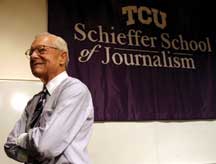 effer School of Journalism in October. effer School of Journalism in October.
During the visit — his first time on campus since the school’s naming ceremony in March — Schieffer recounted how he and Barbara Walters gained an exclusive interview with Egyptian President Anwar Sadat by dancing up to him during a New Year’s Eve Party in 1977.
“I hate telling people we danced our way to the story, but that is what happened,” Schieffer said.
Schieffer encouraged journalism students to work diligently and not get discouraged if they have trouble getting a job on the first try. CBS turned him down for five years, he said.

Kinky point of view
Author/musician and wanna-be-governor Kinky Friedman was on campus in November sporting a cowboy hat, a cigar, a sense of humor and a plan for running the state of Texas.
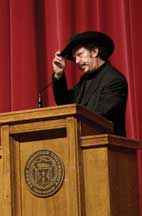
Sponsored by the TCU College Democrats, the independent gubernatorial hopeful shared thoughts on topics such as gay marriage, the environment, education, teachers’ salaries and the need to put young people in positions of authority on state boards.
On public education in Texas, Friedman commented: “What needs to be done is the notion of teaching to the test needs to be thrown out the window. Every teacher in Texas knows this.”
And on changes to public university boards and other state posts, Friedman said he would appoint, “… the very best people simply because they’re the very best people. And then I’m going to get the hell out of their way and let them work.”

Representing education
State Rep. Lois Winkelmann Kolkhorst ‘87, a champion of private higher education, stands out for her leadership and her support of TCU.
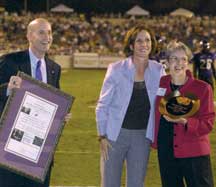
Kolkhorst, a Brenham native, four-year golf letter winner and All-Academic Southwest Conference athlete during her time at TCU, received a citation at the Nov. 5 football game for her support of Texas Education Grants. The grants provide financial aid for students to attend private universities. Shown here: Chancellor Victor J. Boschini, Jr., Kolkhorst and Carol McDonald, president of Independent Colleges and Universities of Texas, Inc. (ICUT).

In Brief
TCU students are apparently choosing treadmills over cheeseburgers. The university was ranked the 12th fittest college in the nation by the October issue of Men’s Fitness. The magazine, which surveyed students at more than 660 colleges and universities, gave the school an “A” for its culture of fitness.
Once again, TCU is ranked among the top 100 universities in the nation, according to U.S. News and World Report. The university is 97th in the magazine’s Best Colleges poll for 2006, one spot higher than a year ago.
The M.J. Neeley School of Business has been ranked No. 18 in the nation among regional programs by The Wall Street Journal Guide to Top Business Schools. The Neeley School was the top-ranked business school in the state, finishing ahead of The University of Texas at Austin, SMU, Texas A&M and Rice.
The business school was also ranked No. 2 in best campus facilities and No. 9 in greatest opportunity for women in the 2006 edition of the “Best 237 Business Schools” by The Princeton Review.
The TCU Recreation Center received a bronze award from the International Association for Sports and Leisure Facilities. The award recognizes outstanding architectural design and facility management.

TCU Tomes
That Godless Court: Supreme Court Decisions on Church-State Relationships
By Ronald B. Flowers
Westminster John Knox Press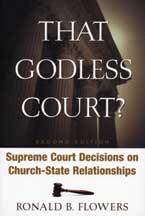
Lawyers, scholars and pastors alike may gain perspective from this second edition, which clarifies sometimes-volatile church-state issues. Flowers, emeritus religion professor, tackles topics from congregational fights to pacifism and includes cases up to 2004 in this comprehensive account of the Supreme Court. To order, go to www.wjkbooks.com.
To Marry an Indian: The Marriage of Harriet Gold and Elias Boudinot in Letters, 1823-1839
By Theresa Strouth Gaul, editor
University of North Carolina Press
TCU assistant English professor Theresa Gaul takes an intimate look at 19th-century race relations through family letters concerning the relationship between a 20-year-old white woman from a privileged Connecticut family and a prominent Cherokee statesman and journalist. To order go to www.uncpress.unc.edu or call 800.848.6224.

A Conversation with J’Nell L. Pate ’60
America’s Historic Stockyards: Livestock Hotels
By J.Nell L. Pate ‘60
TCU Press
There was a time when guests of major cities’ large hotels were of the four-footed variety. J’Nell Rogers Pate ’60 examines how stockyards helped to establish some of America’s greatest cities and how the era, the people and the markets themselves recount a significant part of the history of America’s meat industry.
Q: What is a “livestock hotel”?
A: It’s a nickname for the facilities at the stockyard. Animals “checked in” sometimes for an overnight stay. Stockyard owners provided the “room” (a pen) and charged a fee. Stockyard workers became the “porters” who fed and watered them. Even a house doctor (a veterinarian) was available.
Q: How did America’s historic stockyards become such large businesses?
A: For nearly a century and a half the large and small stockyards in this country, located at rail centers in cities across America, were the major means of livestock marketing. Texas longhorn cattle headed north in large drives to the railheads, and meat slaughterers (called meatpackers) installed large plants near railroad terminals. Businessmen with railroading or meatpacking backgrounds constructed stockyards at these rail junctions. The meat industry became the largest business in America from the 1880s to 1900.
Q: What role did the author Upton Sinclair play in the history of the stockyards and meatpacking industry?
A: The young socialist writer Upton Sinclair protested the conditions at the Chicago slaughtering plants and urged that the government take over ownership of them in his well-known book The Jungle. He inspired meatpacker J. Ogden Armour to write a rebuttal called The Meat Packers: the Private Car Lines and the People which argued that conditions were not as bad as Sinclair claimed. The actual result of Sinclair’s book was a new law requiring government inspection of meat.
Q: How did the meatpacking industry affect the stockyards?
A: The stockyards provided an efficient place to buy and sell animals for meat consumption. When the meatpacking industry moved from the cities to rural areas near feedlots, the large stockyards began to decline.
Q: How did the stockyard industry go from large centrally located stockyard companies to the local livestock auction?
A: The trend for local auctions began in the 1930s after the government regulated the big stockyards. The states and the federal government also began “good roads” programs. Farmers could put a couple of animals in a truck and take them to a nearby local market.
Q: What caused the ultimate demise of large stockyard companies?
A: By the 1950s and 1960s meatpacking plant owners found that building new plants nearer the ranches and farms was more efficient than renovating aging facilities. Meatpackers could purchase animals for their new plants at feedlots and local auctions.
Q: How did Fort Worth become one of the major livestock markets?
A: Longhorn cattle multiplied in South Texas during the Civil War, so much so that there were more cattle in Texas than people. Cattle sold for $4 per head, but the east coast would pay $40. Thus began the long drives northward to meet the railroad. Fort Worth was on the edge of settlement in the late 1860s, and the herds came through. Businessmen in the city were progressive enough to seek out a railroad, meatpacking plants, and stockyards facilities. When they persuaded the two largest of the Big Four meatpackers of America to build new, modern plants on the north side of Fort Worth in 1902, the city’s growth as a large market was assured. Fort Worth remained the largest market in the entire Southwest for over half a century.
Q: Why didn’t it surpass Chicago’s market?
A: Chicago was the well-established railroad hub of Midwestern trade. More packing plants had located there. However, Fort Worth was not hog country. We were cattle country and continued to supply all the cattle that the packers could handle. Meat-packers wanted to slaughter as many hogs or more as they did cattle, but they couldn’t do it in Fort Worth. Fort Worth outlasted Chicago, however.
To purchase, call 1.800.826.8911 or send an e-mail to tcupress@tcu.edu.
|



